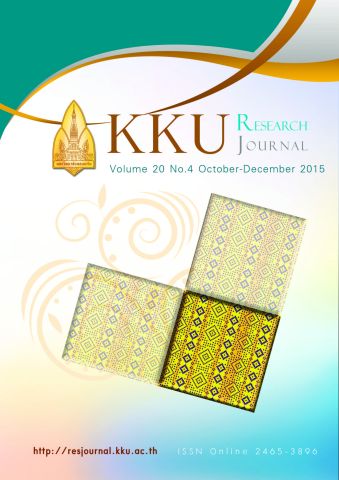Fungi on dragon fruit in Loei province, Thailand and the ability of bipolaris cactivora to cause post-harvest fruit rot
Main Article Content
Abstract
Dragon fruit [Hylocereus undatus (Haworth) Britton & Rose] grown in Loei province is one of dragon fruit cultivars with high quality and rich of sweetness compared to the fruits from other areas. There were some fungal infections observed in post-harvested diseases caused serious damage on the fruits leading to serious damages to the produces. Therefore, Fungi were isolated from three infected parts of the plants e.g. stems, flowers and fruits, in relevant to the causative pathogens. Two fungal species, Alternaria sp. and Phomopsis sp. were found on the stems. Six species, Bipolaris cactivora, Cladosporium cucumerinum, Fusarium sp., Alternaria sp. and Colletotrichum gloeosporiodes were obtained from rotten flowers. From the fruits, three fungi, B. cactivora, C. gloeosporiodes and Rhizopus stolonifer were isolated. The most frequently species isolated from the fruits was B. cactivorawas the most frequently isolates from the fruits and some epidemiological aspects of the pathogen were studied in details.
Article Details
References
Am J Appl Sci. 2009 May 1; 6(5):902–12.
[2] Ghani MA, Awang Y, Sijam K. Disease occurrence and fruit quality of pre-harvest calcium treated red flesh dragon fruit (Hylocereus polyrhizus ). Afr J Biotechnol. 2013 Aug 22;10(9):1550–8.
[3] Guo LW, Wu YX, Ho HH, Su YY, Mao ZC, He PF, He YQ. First report of dragon fruit (Hylocereus undatus) anthracnose caused by Colletotrichum truncatum in China. J Phytopathol. 2014;162(4):272–5.
[4] Hawa MM, Salleh B, Latiffah Z. Characterization and intraspecific variation of Fusarium semitectum (Berkeley and Ravenel) associated with red-fleshed dragon fruit ( Hylocereus polyrhizus [Weber] Britton and Rose) in Malaysia. Afr J Biotechnol. 2010; 9(3): 273-84
[5] Hawa MM, Salleh B, Latiffah Z. Characterization and pathogenicity of Fusarium proliferatum causing stem rot of Hylocereus polyrhizus in Malaysia. Ann Appl Biol. 2013;163(2):269–80.
[6] Valencia-Botín AJ, Sandoval-Islas JS, Cárdenas-Soriano E, Michailides TJ, Rendón-Sánchez G. Botryosphaeria dothidea causing stem spots on Hylocereus undatus in Mexico. Plant Pathol. 2003;52(6):803–803.
[7] Ben-Ze’ev IS, Assouline I, Levy E, Elkind G. First report of Bipolaris cactivora causing fruit blotch and stem rot of dragon fruit (pitaya) in Israel. Phytoparasitica. 2011 Apr 1;39(2):195–7.
[8] Tarnowski TLB, Palmateer AJ, Crane JH. First Report of Fruit Rot on Hylocereus undatus Caused by Bipolaris cactivora in South Florida. Plant Dis. 2010 Dec;94(12):1506–1506.
[9] Athipunyakom P, Seemadua S and Doungsa-ard C. Fruit rot of dragon fruit caused by Bipolaris cactivora. The 9th National Plant Protection Conference. Thailand. 2009,230.
[10] Pest List for Dragon Fruit from Thailand [Internet]. [cited 2013 Dec 9]. Available from: https://www.acfs. go.th/FileSPS/TextSPS%20 USA%202239.pdf
[11] Taba S, Miyahira N, Nasu K, Takushi T, Moromizato Z. Fruit rot of Strawberry pear (pitaya) caused by Bipolaris cactivora. J Gen Plant Pathol. 2007 Oct 1;73(5):374–6.
[12] He PF, Ho H, Wu X, Hou MS, He YQ. Bipolaris cactivora causing fruit rot of dragon fruit imported from Vietnam. Plant Pathol Quar. 2012;2:31–5.
[13] Durbin RD, Davis LH, Baker KF. A Helminthosporium stem rot of cacti. Phytopatholo- gy. 1955;45(9):509–12.
[14] Kim JH, Jeoung MI, Hyun IH, Kim YH. Potential Biotypes in Korean Isolates of Bipolaris cactivora Associated with Stem Rot of Cactus. Plant Pathol J. 2004 Sep;20(3):165–71.
[15] Damm U, Crous PW, Fourie PH. A fissitunicate ascus mechanism in the Calosphaeriaceae, and novel species of Jattaea and Calosphaeria on Prunus wood. Persoonia Mol Phylogeny Evol Fungi. 2008 Jun;20:39–52.
[16] Gramaje D, Agustí-Brisach C, Pérez-Sierra A, Moralejo E, Olmo D, Mostert L, et al. Fungal trunk pathogens associated with wood decay of almond trees on Mallorca (Spain). Persoonia. 2012 Jun;28:1–13.
[17] Ortiz-Hernández YD, Carrillo- Salazar JA. Pitahaya (Hylocereus spp.): a short review. Comun Sci. 2012;3(4):220–37.
[18] Ma T, Yang B, Yu Y, Wang Y, Liu Y, Xu Z, et al. Market Disease Pathogens Detection of Imported Fruits in Shanghai. Agric Sci China. 2009 Sep;8(9):1087–96.
[19] Masirevec SN, Secor GA, Gulya TJ. Use of cell culture to screen sunflower germplasm for resistance to Phomopsis brown/gray stem spot. Plant Cell Rep. 1988 Dec 1;7(7):528–30.
[20] Panahirad S, Zaare NF, Safaralizadeh R, Alizadeh SS. Postharvest Control of Rhizopus stolonifer in Peach (Prunus persicaL. Batsch) Fruits Using Salicylic Acid. J Food Saf. 2012 Nov 1;32(4):502–7.
[21] Valencia-Botín AJ, Kokubu H, Ortíz-Hernández YD. A brief overview on pitahaya (Hylocereus spp.) diseases. Australas Plant Pathol. 2013 Jul 1;42(4):437–40.
[22] Ellis MB. Dematiaceous Hyphomycetes. Commonwealth Mycological Institute: Kew; 1971.
[23] Nakamura S. Helminthosporium stem rot of cacti in Japan. Nogaku Shuho; 1970.
[24] Bae S, Kim SG, Kim YH. Biocontrol characteristics of Bacillus species in suppressing stem rot of grafted cactus caused by Bipolaris cactivora. Plant Pathol J. 2013;29(1):42–51.
[25] Koo HM, Lee SH, Chung IM, Chun SC. Cultural Characteristics of a Seedborne Fungus, Bipolaris spicifera Detected from Imported Grass Seeds into Korea. Mycobiology. 2004;32(4):186.
[26] Farr D, Rossman A. Fungal Databases [Internet]. Systematic Mycology and Microbiology Laboratory. 2015 [cited 2015 Jun 2]. Available from: https://nt. ars-grin.gov/fungaldatabases/new_ allView.cfm?whichone=FungusHost&thisName=Bipolaris%20 cactivora&organismtype=Fungus&fromAllCount=yes
[27] Wegulo SN. Symptoms and Signs. Available from: https://www.apsnet. org/edcenter/ intropp/ lessons/ fungi/ascomycetes/Pages/TanSpot. aspx
[28] Loei Thailand local weather [cited 2014 Aug 13]. Available from: https://www.accuwea ther.com/en/ th/loei/319038/weather- forecast/319038
[29] Sornvilai S, Kasee C, Chaidee A and Sangchote S. Postharvest fruit rot of pitaya fruits (Hylocercus undatus (Haw) Brit.&Rose.) and its control. 10th National Postharvest Technology Conference. 23-24 August 2012, Centara Hotel&Conventional Centre, KhonKaen. (Abstract) p.49.
[30] Le Bellec F , Vaillant F and Imbert E.‘Pitahaya ( Hylocereus spp.): a new fruit crop, a market with a future’ , 2006, Fruits , 61 , 237 – 250 .
[31] Gunasen HPM, Pushapakumara DKNG and Kariyawasam M. Dragon fruit – Hylocereus undatus (Haw.) Britton and Rose: field manual for extension workers. Sri Lanka Council for Agricultural Policy, Wijerama Mawatha, 2006, Colombo 7, Sri Lanka.


